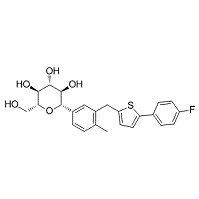| Description: |
Canagliflozin is a selective SGLT2 inhibitor with IC50s of 2 nM, 3.7 nM, and 4.4 nM for mSGLT2, rSGLT2, and hSGLT2 in CHOK cells, respectively. |
| In Vivo: |
Canagliflozin treatment (1 mg/kg) notably lowers renal threshold for glucose excretion (RTG) in Zucker diabetic fatty (ZDF) rats to 94±10 mg/dL. In the second study, an insulin infusion is given to lower blood glucose (BG) to approximately 25 mg/dL, and then the graded glucose infusion (GGI) is given to slowly raise BG to approximately 300 mg/dL. In ZDF rats treated with Canagliflozin (1 mg/kg), the relationship between BG and urinary glucose excretion (UGE) remains well-described by a threshold relationship with negligible UGE occurring when BG<90 mg/dL and UGE increases in proportion to BG at higher BG levels. In db/db mice, single doses of Canagliflozin dose-dependently reduces non-fasting BG concentrations. The onset of the BG-lowering effect after a single dose is rapid, and BG levels in Canagliflozin-treated mice (at 1 and 10 mg/kg doses) are significantly different from those of vehicle-treated mice at 1 hour after treatment (22% and 36% reduction of BG levels compared with that in vehicle-treated mice, respectively)[1]. |
| In Vitro: |
Canagliflozin is a sodium glucose co-transporter (SGLT) 2 inhibitor. In a concentration-dependent fashion, Canagliflozin inhibits Na+-dependent 14C-AMG uptake in CHO-hSGLT2 cells, with an IC50 of 4.4±1.2 nM. Similar IC50 values are obtained in CHO-rSGLT2 and CHO-mSGLT2 cells (IC50=3.7 and 2.0 nM for rat and mouse SGLT2, respectively). Canagliflozin inhibits 14C-AMG uptake in CHO-hSGLT1 and mSGLT1 cells with IC50 of 684±159 nM and >1,000 nM, respectively. At 10 µM, Canagliflozin inhibits the facilitative (non-Na+-linked) GLUT-mediated 3H-2-DG uptake in L6 myoblasts by less than 50%[1]. |






















